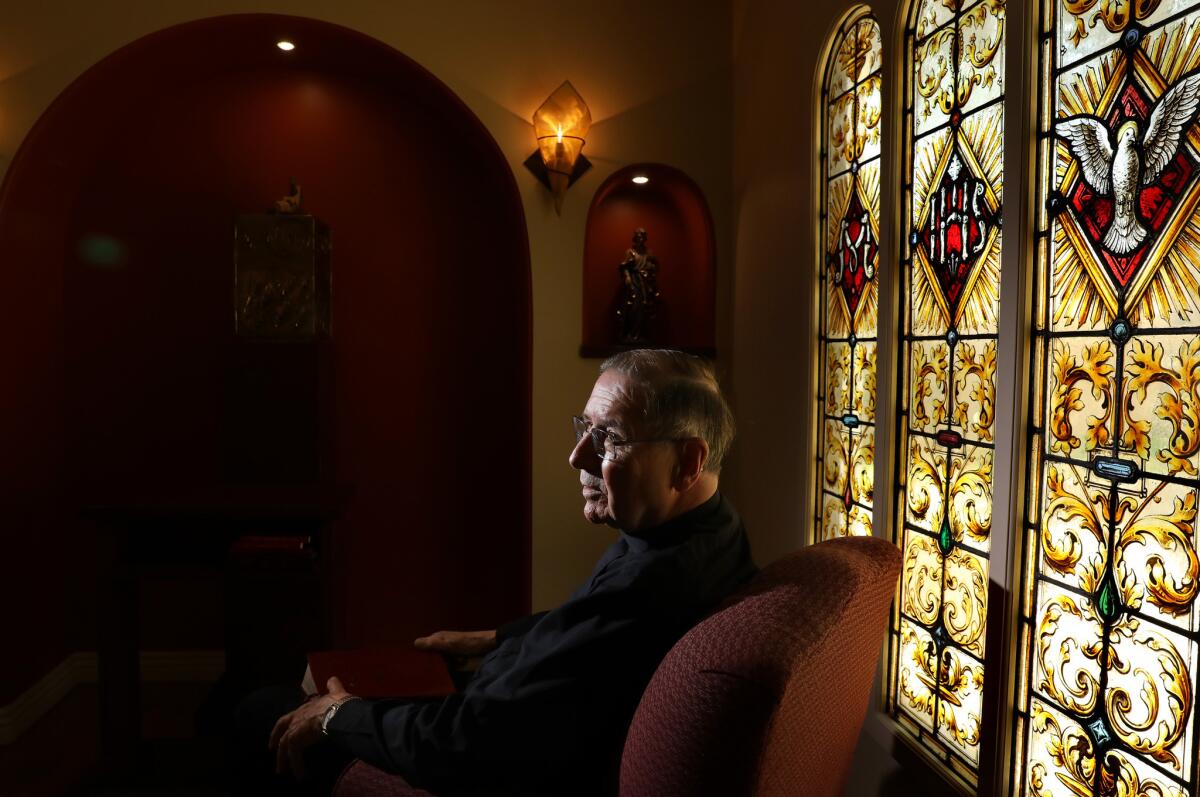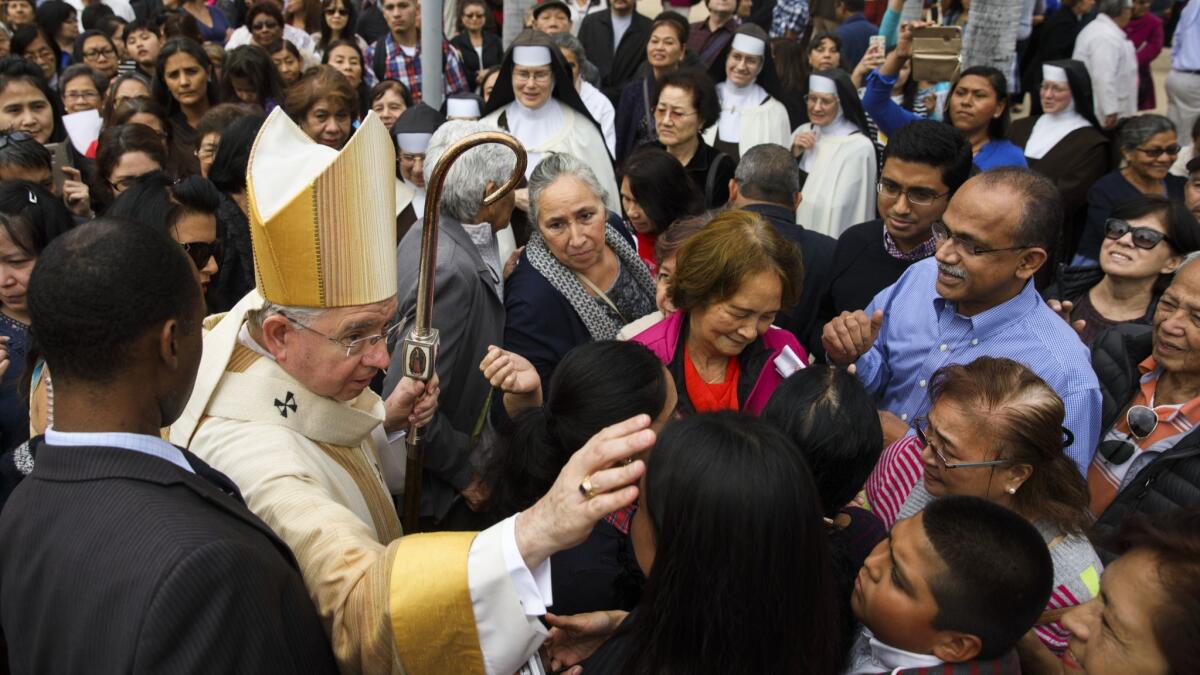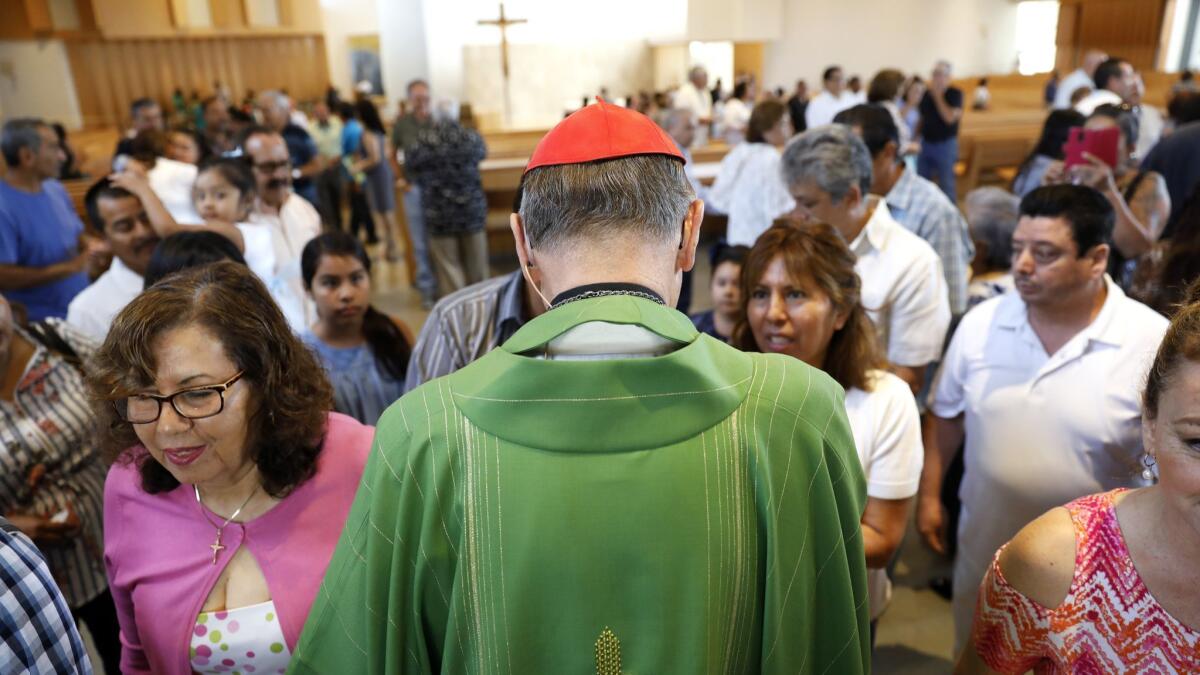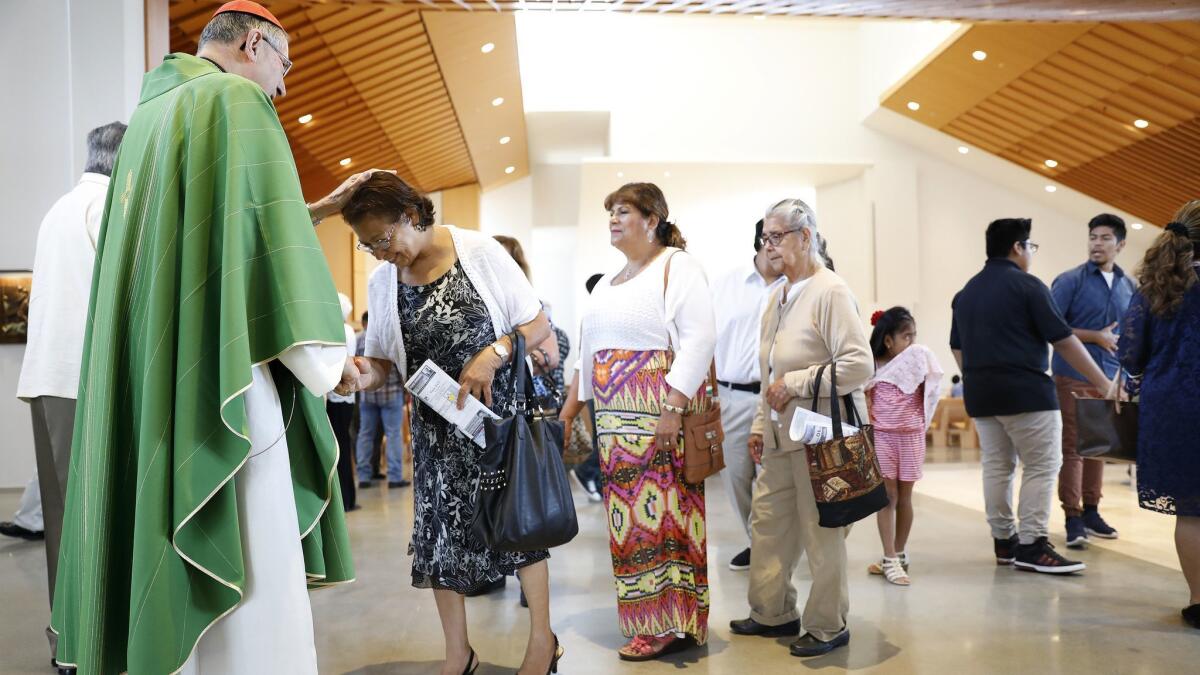In the fight for immigrants, Mahony works out of the spotlight and his successor steps up

Standing beneath the wooden panels of a church in the San Gabriel Valley, Cardinal Roger Mahony delivered a message that has over decades become a refrain.
“Immigrants are our brothers and sisters,” he said, celebrating Mass in Spanish on a recent Sunday. The government may demonize them, but “they aren’t our enemies.”
He told parishioners of their responsibility to fight for reform. The pews erupted with applause.
A politically sophisticated clergyman whom Pope John Paul II nicknamed “Hollywood,” Mahony was raised among California’s immigrant farm workers. Named archbishop of Los Angeles in 1985, he became a powerful voice supporting those who were in the country illegally at a time when California was a pioneer in anti-immigrant measures.
Then came the fall, when he was relieved of public duties over his mishandling of clergy sex abuse of children. Once a shining star of the American church, his reputation suffered as a result of the devastating scandal, which led to the largest settlement by any archdiocese: $660 million.
“It became very difficult to look at him, to listen to him, without thinking this is a guy who messed up on dealing with abuse in the archdiocese,” said Father Thomas J. Reese, a senior analyst at Religion News Service. “It clouded his reputation.”
The cardinal who once filled Dodger Stadium gave way to a successor, Archbishop Jose Gomez, with a more subdued style but a growing voice. On the day before Mahony’s recent sermon, Gomez spoke to thousands of faithful at the Basilica of Our Lady of Guadalupe in Mexico City, near the hill where the Virgin Mary is said to have appeared. He shared the story of a Salvadoran boy who tried to cross the U.S. border three times before finally reuniting with his mother.
Both men have played key, but very different, roles in the the church’s fight for immigration reform.
“Cardinal Mahony was very outspoken, and the public policy debate was something that he would jump into with great vigor and ease. It was something he totally enjoyed,” Reese said. “Gomez, on the other hand, is your classic pastor.… He’s a warm person, he’s personable, he wants to be with his people.”
While Gomez has stepped into the spotlight, Mahony has continued to work on the cause he adopted in his youth — sometimes through a personal blog.
“I was so happy because I no longer had administration, personnel problems, budgets and all that stuff,” Mahony said of turning his official duties over to Gomez. “I was free to do just ministry things. One of my biggest focuses, then, was to continue working with our immigrants.”
Mahony’s views on immigration, once considered radical in a state that backed Proposition 187, are now in the mainstream of California politics. Immigrants today are the main force preventing a sharp decline in church membership nationwide. Some estimates put the U.S. Catholic population at about 70 million. American bishops oppose “enforcement only” policies and support comprehensive immigration reform, a stance that stems from their belief that migration is a humanitarian issue rather than a politically partisan cause.
Year after year, they keep telling us, ‘Mañana, mañana.’ Next year. It makes no difference which political party is in power, there is always some excuse.
— Archbishop Jose Gomez
Faced with the Trump administration’s crackdown on illegal immigration, Gomez has amplified his advocacy. His increasingly public stance comes at a time when Catholics are divided over immigration. About 77% of Latino Catholics favor allowing immigrants who are living in the U.S. illegally an opportunity to become citizens, compared with 55% of white Catholics, according to the Public Religion Research Institute.
“The angry things people today are saying about Mexicans are the same things that were said about earlier generations of Catholics coming to this country,” Gomez said.
The highest-ranking Latino in the U.S. Catholic Church, Gomez recently visited the border in Texas to meet with children separated from their families under the Trump administration’s “zero tolerance” policy and has assembled an immigration task force that includes representatives from the Dioceses of Orange and San Bernardino.
He has reached out to fellow Latino Catholics, who comprise more than 70% of the archdiocese and 52% of Catholics under the age of 30 in the U.S., through a monthly Spanish-language radio and television show and popular gatherings such as the annual procession honoring Our Lady of Guadalupe in East Los Angeles.
“I have been working on this for 30 years,” Gomez, 66, said. “I want to be more vocal.”

For the archbishop, immigration is “the reality of my own family.” The head of the largest and perhaps most diverse archdiocese in the country is himself a naturalized U.S. citizen.
He regularly traveled across the border as a boy, moving between his home in Monterrey, Mexico, and his uncle’s house in San Antonio, Texas. He would go fishing with his father at South Padre Island, using his passport and la mica, a border-crossing card needed to make the journey at the time.
His family has lived in Texas since 1805, when the area was still under Spanish rule. His grandparents were married at the cathedral in San Antonio in 1917.
“I know the people in Mexico. I studied in Rome and in Spain too. I have met all kinds of people, and I know that the American dream is possible,” Gomez said as he drove through Monterrey during a recent visit. “Integration, that has been the reality in my own life.”
In 2013, he released a book that voiced his support for a path to citizenship for the estimated 11 million immigrants living in the country without legal status. His advocacy aligns with efforts by Pope Francis to raise awareness about the challenges immigrants face.
Although Gomez may not receive as much recognition as Mahony for taking up immigration issues outside the church, experts say he plays an indispensable role in the institution.
“Mahony was an early leader on this topic,” Reese said. “Whereas Gomez is working today, when everyone is talking about this. And he’s Mexican American, and so people shrug and say of course he’s in support; that’s his people.”
John Carr, an expert in Catholicism at Georgetown University, said “it would be a big mistake to underestimate Gomez’s influence.”
“One may have felt more comfortable in the press and the other in the pulpit, but both are a good place to make the point,” he said.
Two weeks ago, at a special Mass dedicated to immigrants, Gomez delivered a forceful message to more than 3,000 congregants inside the Cathedral of Our Lady of the Angels.
“Year after year, they keep telling us, ‘Mañana, mañana.’ Next year,” he said, referring to calls for immigration reform. “It makes no difference which political party is in power, there is always some excuse.”
The need for reform can no longer be ignored, Gomez said.
“The inaction of our government is breaking up families and hurting children — and doing it in our name, in the name of America,” he said.

Gomez and Mahony both argue that technology and social media have provided new tools for the church to spread its message, rather than drowning it out.
Mahony pointed to the bishops’ “Justice For Immigrants” website, which provides resources to help immigrants here illegally. Gomez launched a similar site called “Next America” and has regularly tweeted pastoral messages and posted statements on why it is important for the faithful to advocate for reform.
But the church could be doing more to take advantage of social media, said Kevin Appleby, an expert in international migration policy at the Center for Migration Studies.
“They can no longer rely solely on speaking from the pulpit or issuing statements,” he said. “They need to work on getting the message to young people.”
The Catholic Church has consistently been pro-immigrant.
In 2006, Mahony said he would instruct his priests to defy potential legislation that would have required churches and other social organizations to ask immigrants for legal documentation before providing assistance and penalized them if they refused to do so.
“That might not be Archbishop Gomez’s style,” Appleby said, but “he is a leading voice of reform.… He has done more than anyone else to appeal to conservatives in the church.”
The archbishop said his biggest challenge doesn’t come from the volume of voices speaking up for immigrants. Rather, he sees a challenge in getting elected officials to take action.

Mahony lives on the campus of his childhood parish, St. Charles Borromeo in North Hollywood. His small home has its own chapel, a room where he works on his hobby of tinkering with radios, and a small garden where squash and tomatoes grow.
Hanging in his living room are framed letters from Pope Francis that reference his work on immigration.
Mahony’s lifelong passion for the topic stems from his encounters with migrant workers in the fields of the San Joaquin Valley during his years in the diocese of Fresno and Stockton, and days spent in his family’s poultry processing plant. As a boy, he would sit down with the immigrant employees who worked on the property behind theirs and share ears of corn roasted over a makeshift fire pit.
He attends monthly meetings as a member of Gomez’s immigration task force and celebrates Mass in Spanish in churches throughout the archdiocese almost every weekend, filling in for other priests. Often, his sermons touch on the experience of the immigrant.
“I told the the archbishop, I said, look I’ve got more time. I can go to parish meetings. You are brand new here. You’ve got so many things on your plate that you can’t do a lot of local level stuff that I can do,” Mahony, 82, recalled.
Sitting in a conference room at St. Charles Borromeo, Mahony explained how he told Gomez that he would “stay below the radar.” He said he promised the archbishop that he wouldn’t attend public events that would draw a lot of media and that he wouldn’t make public statements.
“That’s your role and you should do that for us,” Mahony remembers telling him. “And he’s been doing that more and more, and doing that very well.”
Mahony said Trump “doesn’t set a vision that is higher and better” for the country. Instead, he “appeals at the bottom to people’s fears,” he said.
“Every immigrant belongs to MS-13, they’re going to rob your home, steal your wife, take your jobs, ruin the economy,” he said. “Which of course is ridiculous.”
A bishop in good standing despite his handling of the sex abuse scandal, Mahony also has remained involved in the grassroots efforts he drew up during his tenure, working with local churches to train teams of parishioners who hold information sessions on immigration and pathways to citizenship.
His dedication to immigration extends beyond working with immigrants who have fled violence in Central America. He also visits countries such as Lebanon and Jordan, where the church’s international humanitarian agency, Catholic Relief Services, aids refugees.
This fall, he plans to meet refugees in Africa, including Kenya and Uganda.
“I could never do that before,” Mahony said. He smiled. “Now I can.”
For more California news follow me on Twitter: @sarahparvini
Sign up for Essential California
The most important California stories and recommendations in your inbox every morning.
You may occasionally receive promotional content from the Los Angeles Times.








